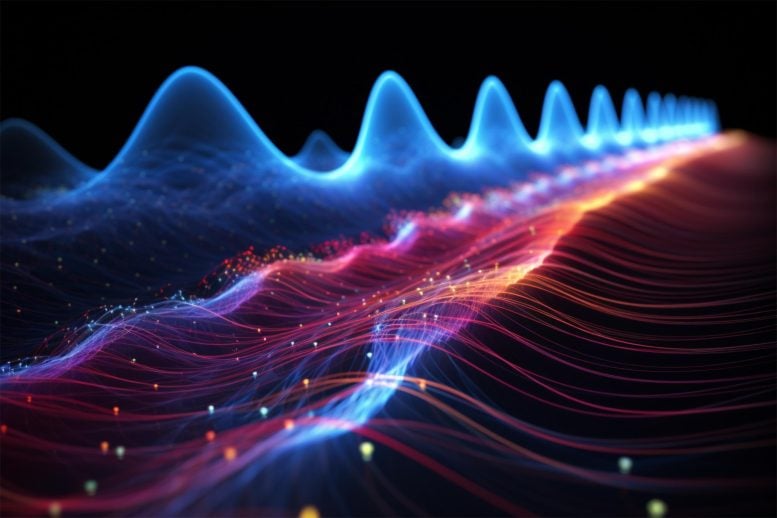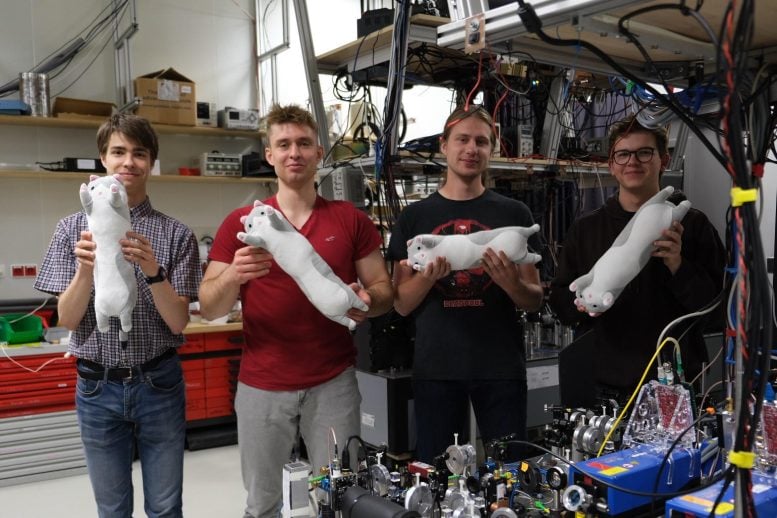
World-First Fractional Fourier Transform of Optical Pulses Using Quantum Memory
Researchers from the University of Warsaw’s Faculty of Physics, in collaboration with experts from the QOT Centre for Quantum Optical Technologies, have pioneered an innovative technique that allows the fractional Fourier Transform of optical pulses to be performed using quantum memory.
This achievement is unique on the global scale, as the team was the first to present an experimental implementation of the said transformation in this type of system. The results of the research were published in the prestigious journal Physical Review Letters. In their work, the students tested the implementation of the fractional Fourier Transform using a double optical pulse, also known as a “Schrödinger’s cat” state.
The spectrum of the pulse, and temporal distribution
Waves, such as light, have their own characteristic properties — pulse duration and frequency (corresponding, in the case of light, to its color). It turns out that these characteristics are related to each other through an operation called the Fourier Transform, which makes it possible to switch from describing a wave in time to describing its spectrum in frequencies.
The fractional Fourier Transform is a generalization of the Fourier Transform that allows a partial transition from a description of a wave in time to a description in frequency. Intuitively, it can be understood as a rotation of a distribution (for example, the chronocyclic Wigner function) of the considered signal by a certain angle in the time-frequency domain.

It turns out that transforms of this type are exceptionally useful in the design of special spectral-temporal filters to eliminate noise and enable the creation of algorithms that make it possible to use the quantum nature of light to distinguish pulses of different frequencies more precisely than traditional methods. This is especially important in spectroscopy, which helps study the chemical properties of matter, and telecommunications, which requires the transmission and processing of information with high precision and speed.
Lenses, and the Fourier Transform?
An ordinary glass lens is capable of focusing a monochromatic beam of light falling on it to almost a single point (focus). Changing the angle of incidence of light on the lens results in a change in the position of the focus. This allows us to convert angles of incidence into positions, obtaining the analogy of the Fourier Transform, in the space of directions and positions. A classical spectrometer based on a diffraction grating uses this effect to convert the wavelength information of light into positions, allowing us to distinguish between spectral lines.
Time and Frequency Lenses
Similarly to the glass lens, time and frequency lenses allow the conversion of a pulse’s duration into its spectral distribution, or effectively, perform a Fourier transform in time and frequency space. The right selection of powers of such lenses makes it possible to perform a fractional Fourier Transform. In the case of optical pulses, the action of time and frequency lenses corresponds to applying quadratic phases to the signal.
To process the signal, the researchers used a quantum memory — or more precisely a memory equipped with quantum light processing capabilities — based on a cloud of rubidium atoms placed in a magneto-optical trap. The atoms were cooled to a temperature of tenths of millions of degrees above absolute zero. The memory was placed in a changing magnetic field, allowing components of different frequencies to be stored in different parts of the cloud. The pulse was subjected to a time lens during writing and reading, and a frequency lens acted on it during storage.
The device developed at the UW allows the implementation of such lenses over a very wide range of parameters and in a programmable way. A double pulse is very prone to decoherence, hence it is often compared to the famous Schrödinger cat — a macroscopic superposition of being dead and alive, almost impossible to achieve experimentally. Still, the team was able to implement faithful operations on those fragile dual-pulse states.
The publication was the result of work in the Quantum Optical Devices Laboratory and Quantum Memory Laboratory in the “Quantum Optical Technologies” center with the participation of two master’s students: Stanislaw Kurzyna and Marcin Jastrzebski, two undergraduate students Bartosz Niewelt and Jan Nowosielski, Dr. Mateusz Mazelanik, and lab heads Dr. Michal Parniak and Prof. Wojciech Wasilewski. For the described results, Bartosz Niewelt was also awarded a presentation grant award during the recent DAMOP conference in Spokane, WA.
Before direct application in telecommunications, the method must first be mapped to other wavelengths and parameter ranges. Fractional Fourier transform, however, could prove crucial for optical receivers in state-of-the-art networks, including optical satellite links. A quantum light processor developed at the UW makes it possible to find and test such new protocols in an efficient way.
References: “Experimental Implementation of the Optical Fractional Fourier Transform in the Time-Frequency Domain” by Bartosz Niewelt, Marcin Jastrzębski, Stanisław Kurzyna, Jan Nowosielski, Wojciech Wasilewski, Mateusz Mazelanik and Michał Parniak, 12 June 2023, Physical Review Letters.
DOI: 10.1103/PhysRevLett.130.240801
The “Quantum Optical Technologies” (MAB/2018/4) project is carried out within the International Research Agendas program of the Foundation for Polish Science co-financed by the European Union under the European Regional Development Fund.
Never miss a breakthrough: Join the SciTechDaily newsletter.
8 Comments
Schrödinger’s cat is the most absurd analogy in the history of human science.
If you are really interested in science, you can browse https://zhuanlan.zhihu.com/p/624024548.
“The atoms were cooled to a temperature of tens of millions of degrees above absolute zero” – pretty sure this is not correct.
The original paper states “The ensemble temperature is 42 μK”, so perhaps the article meant to say a mere tens of millionths of a degree above absolute zero (instead of tens of millions of degrees).
Off topic but similar. Just thought about this and the two slit experiment. What if there are dynamics we don’t yet understand of the weight of a photon. What if that weight pulls the phone into what seems a wave pattern when in fact were multiple different particles of specific weights each to a whole of itself which shifts the photon sure to gravity, density of mass, speed of light, and the particle variant? Another unexplained experiment where one thing appears as two when in fact it is one, potentially grabbed in one direction or the next. In these experiments there are always anomalies that don’t fit but there is a predominant line that is shown in what we call a wave format. But what if it was time that changed, space, over the course of a few inches that cause this effect. It would also explain this article as a secondary thought
I’m not a physicist but as an interested engineer I have known of Schrödinger Cat analogy for decades and have long had the feeling which Zhang expresses above. Can no one make a simple more clear explanation for the layman and young students that are interested and might become inspired by such aspects of quantum physics ?
Schrödinger’s Cat is the simple and clear explanation. Tho, it was originally made to demonstrate how ridiculous the ideas of quantum mechanics are, it’s pure oddness gives a wonderful intuition to the unusual rules of QM. It’s just super position. An electron can be both up and down. A photons goes thru both the left and right slits. The cat is both dead and alive.
The essence of philosophy for Schrödinger’s cat is the unity of opposites. Topological vortex is point in 2D field. Observing the vortex simultaneously in front and behind of 2D field, if clockwise rotation is observed in front of the vortex, then counterclockwise rotation will be observed in behind of the vortex. The unity of opposites of clockwise rotation and counterclockwise rotation, which is not only for the observers, that is the same in the interaction of vortices. Cat is a high-dimensional space-time material. It is unscientific to use cat to analogy low-dimensional space-time material. That can easily lead to misunderstanding and ambiguity. With the deepening of the study about topological vortex field, human science’s understanding about the laws of material motion is expected to be perfectly solved in topological space-time. Mr.Schrödinger’s half-dead cat and poison bottle should probably end and go into history. If you are interested, you can browse https://www.zhihu.com/column/c_1278787135349633024.
That pesky cat has been ZHANGED!